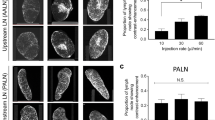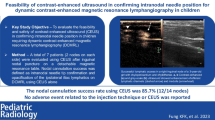Abstract
Objectives
To evaluate the optimal imaging protocol and the feasibility of intranodal dynamic contrast-enhanced computed tomography lymphangiography (DCCTL) in microminipigs.
Methods
The Committee for Animal Research and Welfare provided university approval. Five female microminipigs underwent DCCTL after inguinal lymph node injection of 0.1 mL/kg of iodine contrast media at a rate of 0.3 mL/min with three different iodine concentrations: group 1, 75 mgI/mL; group 2, 150 mgI/mL; and group 3, 300 mgI/mL. The CT values of the venous angle, thoracic duct (TD), cisterna chyli, iliac lymphatic duct, and iliac lymph node were measured; increases in CT values pre- to post-contrast were assessed as the contrast-enhanced index (CEI). Multi-detector row CT (MDCT) and volume rendering images showing the highest CEI were qualitatively evaluated.
Results
The CEI of all lymphatics peaked at 5–10 min. The mean CEI of TD at 10 min of group 2 (193.0 HU) and group 3 (201.5 HU) were significantly higher than that of group 1 (70.7 HU) (p = 0.024). The continuity and overall diagnostic acceptability of all lymphatic system components were better in group 3 (3.6 and 3.0, respectively) than group 1 (2.6 and 1.6) and group 2 (3.0 and 2.6) (p = 0.249 and 0.204).
Conclusions
The optimal imaging protocol for intranodal DCCTL could be dual-phase imaging at 5 and 10 min after the injection of 300 mgI/mL iodinated contrast media. DCCTL provided good images of lymphatics and is potentially feasible in clinical settings.
Key Points
• Dynamic contrast-enhanced computed tomography lymphangiography with intranodal injection of water-soluble iodine contrast media showed the highest enhancement of all lymphatics at scan delays of 5 and 10 min.
• The optimal iodine concentration for intranodal dynamic contrast-enhanced computed tomography lymphangiography might be 300 mgI/mL.
• Intranodal dynamic contrast-enhanced computed tomography lymphangiography provided good images of all the lymphatic system components and is potentially feasible in clinical settings.




Similar content being viewed by others
Abbreviations
- CC:
-
Cysterna chyli
- CEI:
-
Contrast-enhanced index
- DCCTL:
-
Dynamic contrast-enhanced computed tomography lymphangiography
- DCMRL:
-
Dynamic contrast-enhanced magnetic resonance lymphangiography
- ILD:
-
Iliac lymphatic duct
- ILN:
-
Iliac lymph node
- TD:
-
Thoracic duct
- VA:
-
Venous angle
References
Hsu MC, Itkin M (2016) Lymphatic anatomy. Tech Vasc Interv Radiol 19:247–254
Lv S, Wang Q, Zhao W et al (2017) A review of the postoperative lymphatic leakage. Oncotarget 8:69062–69075
Matsumoto T, Yamagami T, Kato T et al (2009) The effectiveness of lymphangiography as a treatment method for various chyle leakages. Br J Radiol 82:286–290
Kawasaki R, Sugimoto K, Fujii M et al (2013) Therapeutic effectiveness of diagnostic lymphangiography for refractory postoperative chylothorax and chylous ascites: correlation with radiologic findings and preceding medical treatment. AJR Am J Roentgenol 201:659–666
Dori Y, Zviman MM, Itkin M (2014) Dynamic contrast-enhanced MR lymphangiography: feasibility study in swine. Radiology 273:410–416
Krishnamurthy R, Hernandez A, Kavuk S, Annam A, Pimpalwar S (2015) Imaging the central conducting lymphatics: initial experience with dynamic MR lymphangiography. Radiology 274:871–878
Nadolski GJ, Ponce-Dorrego MD, Darge K, Biko DM, Itkin M (2018) Validation of the position of injection needles with contrast-enhanced ultrasound for dynamic contract-enhanced MR lymphangiography. J Vasc Interv Radiol 29:1028–1030
Pimpalwar S, Chinnadurai P, Chau A et al (2018) Dynamic contrast enhanced magnetic resonance lymphangiography: categorization of imaging findings and correlation with patient management. Eur J Radiol 101:129–135
Chick JFB, Nadolski GJ, Lanfranco AR, Haas A, Itkin M (2019) Dynamic contrast-enhanced magnetic resonance lymphangiography and percutaneous lymphatic embolization for the diagnosis and treatment of recurrent chyloptysis. J Vasc Interv Radiol 30:1135–1139
Iwanaga T, Tokunaga S, Momoi Y (2016) Thoracic duct lymphography by subcutaneous contrast agent injection in a dog with chylothorax. Open Vet J 6:238–241
Johnson EG, Wisner ER, Kyles A, Koehler C, Marks SL (2009) Computed tomographic lymphography of the thoracic duct by mesenteric lymph node injection. Vet Surg 38:361–367
Kim M, Lee H, Lee N et al (2011) Ultrasound-guided mesenteric lymph node iohexol injection for thoracic duct computed tomographic lymphography in cats. Vet Radiol Ultrasound 52:302–305
Dong J, Xin J, Shen W et al (2018) Unipedal diagnostic lymphangiography followed by sequential CT examinations in patients with idiopathic chyluria: a retrospective study. AJR Am J Roentgenol 210:792–798
Takasu M, Maeda M, Almunia J, Nakamura K, Nishii N, Takashima S (2018) Response to estrus induction with abortion treatment in microminipigs on different days after insemination. J Reprod Dev 64:361–364
Baek Y, Won JH, Kong TW et al (2016) Lymphatic leak occurring after surgical lymph node dissection: a preliminary study assessing the feasibility and outcome of lymphatic embolization. Cardiovasc Intervent Radiol 39:1728–1735
Alomari MH, Lillis A, Kerr C, Newburger JW, Quinonez L, Alomari AI (2019) The use of non-ionic contrast agent for lymphangiography and embolization of the thoracic duct. Cardiovasc Intervent Radiol 42:481–483
Kariya S, Komemushi A, Nakatani M, Yoshida R, Kono Y, Tanigawa N (2014) Intranodal lymphangiogram: technical aspects and findings. Cardiovasc Intervent Radiol 37:1606–1610
Inoue M, Nakatsuka S, Yashiro H et al (2016) Lymphatic intervention for various types of lymphorrhea: access and treatment. Radiographics 36:2199–2211
Itkin M (2016) Lymphatic intervention techniques: look beyond thoracic duct embolization. J Vasc Interv Radiol 27:1187–1188
Takasawa C, Seiji K, Matsunaga K et al (2012) Properties of N-butyl cyanoacrylate-iodized oil mixtures for arterial embolization: in vitro and in vivo experiments. J Vasc Interv Radiol 23(1215–1221):e1211
Wortman JR, Uyeda JW, Fulwadhva UP, Sodickson AD (2018) Dual-energy CT for abdominal and pelvic trauma. Radiographics 38:586–602
Acknowledgments
We thank Richard Lipkin, PhD, from Edanz Group (www.edanzediting.com/ac) for editing a draft of this manuscript.
Author information
Authors and Affiliations
Corresponding author
Ethics declarations
Guarantor
The scientific guarantor of this publication is Yukichi Tanahashi, the corresponding author.
Conflict of interest
The authors of this manuscript declare no relationships with any companies whose products or services may be related to the subject matter of the article.
Statistics and biometry
No complex statistical methods were necessary for this paper.
Informed consent
The Committee for Animal Research and Welfare provided university approval.
Ethical approval
The Committee for Animal Research and Welfare provided university approval.
Methodology
• Experimental
Additional information
Publisher’s note
Springer Nature remains neutral with regard to jurisdictional claims in published maps and institutional affiliations.
Yukichi Tanahashi and Satoshi Goshima had moved after the study.
Rights and permissions
About this article
Cite this article
Tanahashi, Y., Iwasaki, R., Shoda, S. et al. Dynamic contrast-enhanced computed tomography lymphangiography with intranodal injection of water-soluble iodine contrast media in microminipig: imaging protocol and feasibility. Eur Radiol 30, 5913–5922 (2020). https://doi.org/10.1007/s00330-020-07031-0
Received:
Revised:
Accepted:
Published:
Issue Date:
DOI: https://doi.org/10.1007/s00330-020-07031-0




